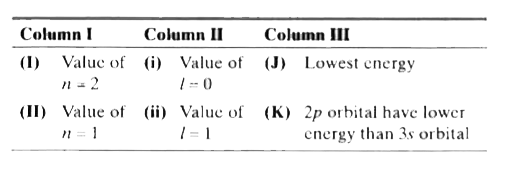If the susbsidiary quantum number of a subenergy level is 4, then no. of degenerate orbitals are
3
5
9
11
The correct Answer is:C
To determine the number of degenerate orbitals when the subsidiary quantum number (l) is given as 4, we can follow these steps:
1. Understanding Quantum Numbers:
- The subsidiary quantum number (l) defines the shape of the orbital and can take values from 0 to (n-1), where n is the principal quantum number. Each value of l corresponds to a specific type of orbital (s, p, d, f, g, etc.).
2. Identifying the Value of l:
- In this case, the subsidiary quantum number is given as l = 4. This corresponds to the f orbital type.
3. Determining the Number of Orbitals:
- The number of degenerate orbitals for a given value of l can be calculated using the formula:
Number of orbitals=2l+1
- Here, substituting l = 4 into the formula gives:
Number of orbitals=2(4)+1=8+1=9
4. Conclusion:
- Therefore, when the subsidiary quantum number is 4, the number of degenerate orbitals is 9.
Final Answer:
The number of degenerate orbitals when the subsidiary quantum number is 4 is 9.
---
- The subsidiary quantum number (l) defines the shape of the orbital and can take values from 0 to (n-1), where n is the principal quantum number. Each value of l corresponds to a specific type of orbital (s, p, d, f, g, etc.).
- In this case, the subsidiary quantum number is given as l = 4. This corresponds to the f orbital type.
- The number of degenerate orbitals for a given value of l can be calculated using the formula:
Number of orbitals=2l+1
- Here, substituting l = 4 into the formula gives:
Number of orbitals=2(4)+1=8+1=9
- Therefore, when the subsidiary quantum number is 4, the number of degenerate orbitals is 9.
The number of degenerate orbitals when the subsidiary quantum number is 4 is 9.
Topper's Solved these Questions
Similar Questions
What are degenerate orbitals ?
View SolutionIn each equation, there is a table having 3 columns and 4 rows. Based on the table, there are 3 questions. Each question has 4 options (a), (b), (c ) and (d), ONLY ONE of these four options is correct.
Four quantum numbers shows the electronic configuration of the element. In the given table, Column I shows the different values of principal quantum number, Column II shows the different values of angular momentum quantum number and Column III shows the energy levels for different orbitals.


What are the characteristics of 2p orbital?
View Solution
Knowledge Check
Degenerate orbital have:
An sameBl sameCm differentDs differentIf the subsidiary quantum number of a subenergy level is 4, the maximum and minimum values of the spin multiplicities are:
A9,1B10,1C10,2D4,−4In each equation, there is a table having 3 columns and 4 rows. Based on the table, there are 3 questions. Each question has 4 options (a), (b), (c ) and (d), ONLY ONE of these four options is correct.
Four quantum numbers shows the electronic configuration of the element. In the given table, Column I shows the different values of principal quantum number, Column II shows the different values of angular momentum quantum number and Column III shows the energy levels for different orbitals.


What are the characteristics of 1s orbital?A(I) (ii) (J)B(IV) (i) (M)C(II) (iv) (K)D(II) (i) (J)
which quantum number determines the number of angular nodes in an atomes orbital ?
View SolutionThe electrons in a poly -electronic atom are filled one by one in roder fo increasing energy level . The enrgy fo subsgells and orientation depeds upon the values of three quantum numbers 9 i.e., n. l and m respectively derived from Schrodinger wave equation . The different orbitals fo a subsshells however possess same energy level and are called degenerater orbitals but their enrgy level charges in presenct fo magentic field and the orbitals are non-degenerate . (A) spectral line is noticed it an electron jups form one level to tohere . the paramgnetic nature of eelment sis due to the presence of unpaired electron .
Total number of valence electrons in NH+4 is :
View SolutionWhen the azimuthal quantum number has the value 2, the number of orbitals possible is
View SolutionThe quantum number which determines the number of sub-energy level is in any main energy level is
View SolutionThe electrons in a poly -electronic atom are filled one by one in roder fo increasing energy level . The enrgy fo subsgells and orientation depeds upon the values of three quantum numbers 9 i.e., n. l and m respectively derived from Schrodinger wave equation . The different orbitals fo a subsshells however possess same energy level and are called degenerater orbitals but their enrgy level charges in presenct fo magentic field and the orbitals are non-degenerate . (A) spectral line is noticed it an electron jups form one level to tohere . the paramgnetic nature of eelment sis due to the presence of unpaired electron .
The ion having maximum number of unpaired eelctrons is :
View Solution
